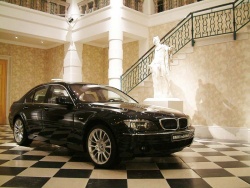 2006 BMW 750Li; photo by Laurance Yap. Click image to enlarge |
|
First Drive 2003 BMW 760iL
Manufacturer’s web site Owner Reviews on autoTRADER.ca |
By Chris Chase
Where early models of the big BMW 7 Series carried themselves with an understated elegance, a 2001 redesign gave the 7 a more controversial look. The change in design direction wasn’t well received by everyone, but its bolder styling no doubt appealed to luxury buyers who wanted to flaunt their wealth.
The 2002 7 Series, codenamed E65, left the gate as the 745i and was powered by a 4.4-litre V8 engine making 325 horsepower. The sole transmission choice was a six-speed automatic. An extended wheelbase version, called the 745Li (codenamed E66) was also available that first year.
In 2004, BMW added a V12 engine option to the long-wheelbase E66 model; the 760Li’s 6.0-litre motor made 438 horsepower. Both engines shared the six-speed transmission, which got a manual-shift function.
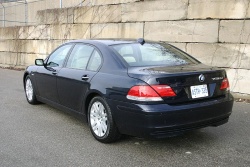 2006 BMW 750Li; photo by Jil McIntosh. Click image to enlarge |
The 2006 7 Series got a new base engine – a 4.8-litre V8 making 360 horsepower – and a new name to go with it: 750i/Li. BMW also gave the car a mid-cycle makeover inside and out.
The E65 7 Series also formed the basis as the only Alpina-tuned BMW available in North America. The slick Alpina B7 was powered by a supercharged version of the early E65’s 4.4-litre engine. With 500 horsepower, this was the closest thing to a factory-backed M7 you could get.
Natural Resources Canada’s EnerGuide fuel consumption ratings for early E65s were 13.1 L/100 km (city) and 8.3 L/100 km (highway) – very respectable numbers for a full-on luxury car.
The 2004 760Li’s big V12 proved far thirstier, earning ratings of 16.1/9.6 (city/highway), and the 2006 750i’s larger base engine proved a little less efficient too, with ratings of 13.8/8.7 (city/highway). The rare 2006 Alpina B7’s supercharged motor was rated at 15.4/9.3 (city/highway).
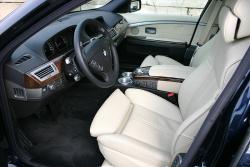 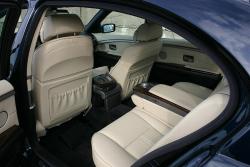 2006 BMW 750Li; photos by Jil McIntosh. Click image to enlarge |
The E65/E66 wasn’t crash tested by the Insurance Institute for Highway Safety (IIHS) or the National Highway Traffic Safety Administration (NHTSA). In fact, not even the European New Car Assessment Programme (Euro NCAP) has crash test data for any generation of 7 Series.
In this thread at BimmerForums.net, E65/66 owners advise avoiding 2002 and 2003 models, as these have typically proven the most trouble-prone model years for this generation 7 Series.
This generation 7 Series is known to have transmission issues. One common problem is that of very rough shifting, particularly when downshifting from second to first gears in low-speed acceleration. This is tied to the transmission’s electronic brain; the procedure detailed in the first post in this thread resets the transmission’s control unit. Rough shifting could also be a sign of a failing transmission.
Another less serious problem is the transmission’s unwillingness to go into gear after the car has been parked for an extended period of time. This, apparently, can create a low voltage situation in the electrical system (from a partly run-down battery, even if there’s enough juice to start the engine). Simply turning the car off, and back on again, is usually enough to fix this relatively minor bug.
If you get a transmission fault warning like this one, the problem is likely a bad seal inside the transmission. It requires the removal of the transmission oil pan, but is a DIY repair for someone handy with cars.
Consumer Reports lists power window failures, leaky sunroofs (which can lead to power seat failures), faulty door handles (and more faulty door handles, keyless entry, navigation and stereo.
As with many high-end cars, the general feeling is that while these cars are wonderful to drive, they are not wonderful to repair. Parts – particularly electronics-intensive components – and labour tend to be expensive.
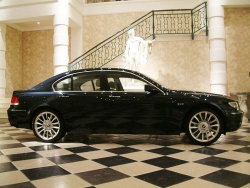 2006 BMW 750Li; photo by Laurance Yap. Click image to enlarge |
Consumer Reports used vehicle data bears out the later-is-better theory, showing 2002 models to be worse, reliability-wise than any other model year, present or past. Still, no model year scores better than average overall.
Click here for an E65/66 BMW FAQ. This thread at BimmerFest.com is an ongoing question-and-answer with a forum member who also happens to be a BMW technician.
The 7 Series is a wonderful car, contentious styling or not, and older versions are surprisingly affordable even for drivers of average means. Those older cars come with more reliability issues than newer versions of the E65, however, which could translate into big repair bills down the road. You may well be able to afford to buy a 2002 745i, but will you have the cash to keep it on the road? That said, even a perfectly-behaved 7 Series will cost a small fortune to maintain.
Black Book Pricing (avg. retail) October, 2012:
|
Year
|
Model
|
Price today
|
Price new
|
|
2008
|
750i
|
$32,275
|
$108,500
|
|
2007
|
750i
|
$25,600
|
$108,500
|
|
2006
|
750i
|
$21,425
|
$100,500
|
|
2005
|
745i
|
$19,100
|
$97,500
|
|
2004
|
745i
|
$16,475
|
$96,800
|
|
2003
|
745i
|
$14,675
|
$96,500
|
|
2002
|
745i
|
$12,800
|
$95,700
|
Online resources
BimmerForums.com and BimmerFest.com are two of the most comprehensive resources I found for 7 Series information. Both have busy forums with knowledgeable members. Also, definitely try the E65 section at RoadfFly.org.
Recalls
Transport Canada Recall Number: 2003168; Units affected: 35
2002-2003: On certain vehicles, due to a software error in the digital engine management control unit, a desynchronization of the valvetronic motors for engine banks 1 and 2 may occur causing a rough-running engine. If this happens, the check engine light will illuminate, and the message “engine malfunction, drive with moderation” will appear in the vehicle’s instrument cluster message display area. In certain extreme cases, the engine could stall and the driver may not be able to restart it. Correction: Dealer will reprogram the digital engine management control unit.
Transport Canada Recall Number: 2002109; Units affected: 471
2002: On certain passenger vehicles the electric fuel pump runs at a rotational speed that could result in reduced lubrication of its internal components. Over an extended period of time, wear-induced internal damage to the fuel pump could result in insufficient fuel supply to the engine when the fuel tank contains one-third or less of its maximum fuel capacity. If this were to occur, the engine could stall and not be restarted until more fuel was added to the fuel tank. This could occur even though the fuel gauge indicated that fuel still remained in the tank. Correction: Dealers will reprogram the fuel pump control system.
Transport Canada Recall Number: 2003202; Units affected: 38
2003: On certain vehicles, insufficient torque may have been applied to the engine oil filter drain plug which could lead to a loosening of the plug causing an initial oil spray and a subsequent oil leak. If this happens, the oil pressure warning light will illuminate, and the message “Engine oil pressure! Stop carefully” will appear in the vehicle’s instrument cluster message display area. If a large amount of oil loss occurs, engine damage may result. Correction: Dealer will retorque the engine oil filter drain plug.
Transport Canada Recall Number: 2004424; Units affected: 1,331
2003-2004: On certain vehicles equipped with heated seats, excessive contact with the seat backrest side bolster upon entering and exiting the vehicle may damage the heating mat located in this area. If this happened, the seated occupant may experience excessive heat in this location. The heating mat could damage, or melt a small hole in the lower portion of the backrest’s outboard side bolster. If this were to occur, an electrical/melting smell or small amount of smoke would be noticeable. In some cases, the small hole in the backrest’s side bolster could damage the seated occupant’s clothing. In rare instances, this could lead to a minor or superficial skin injury. Correction: Dealers will modify the seat heating circuit for the front seat backrests.
Transport Canada Recall Number: 2004266; Units affected: 191
2004: On certain vehicles, the driver’s seat occupant detection system may not be able to reliably determine if the driver’s seat is occupied. As a result, it is possible that in certain crash conditions, the driver’s front airbag, head protection system, safety belt pre-tensioner, and knee airbag may not deploy. Correction: Dealers will reprogram the driver’s seat occupant detection system.
Transport Canada Recall Number: 2004246; Units affected: 355
2004: On certain vehicles, the digital engine management control unit was not produced according to specifications. As a result, engine stalling will occur after a short period of operation. The vehicle may not be able to be restarted. Also, a loss of power steering and, after repeated actuation of the brake pedal, a loss of brake power assistance will occur. If stalling were to occur, the driver would be unable to maintain vehicle speed or accelerate. Steering and braking, while possible, would be difficult. Depending on traffic conditions and the driver’s reactions, this could lead to a crash. Correction: Dealers will replace the digital engine management control unit.
Transport Canada Recall Number: 2006134; Units affected: 912
2006: On certain vehicles, the rear shock lower bushings may not have been manufactured to specification (improper vulcanization of the bushing). Depending on vehicle operation and temperature conditions, this could lead to a loosening of the bushing within its housing. Over time, the bushing could continue to loosen and may eventually separate from its housing. Correction: Dealers will replace the rear strut assemblies.
Transport Canada Recall Number: 2005327; Units affected: 32
2006: On certain vehicles, the guide plate of the automatic transmission’s parking lock pawl subsystem may fail. This could cause the parking lock pawl not to engage, after placing the transmission in the PARK position. If the vehicle was parked on an incline of sufficient grade, and the parking brake was not engaged, the vehicle could roll away. Correction: Dealers will replace the guide plate.











